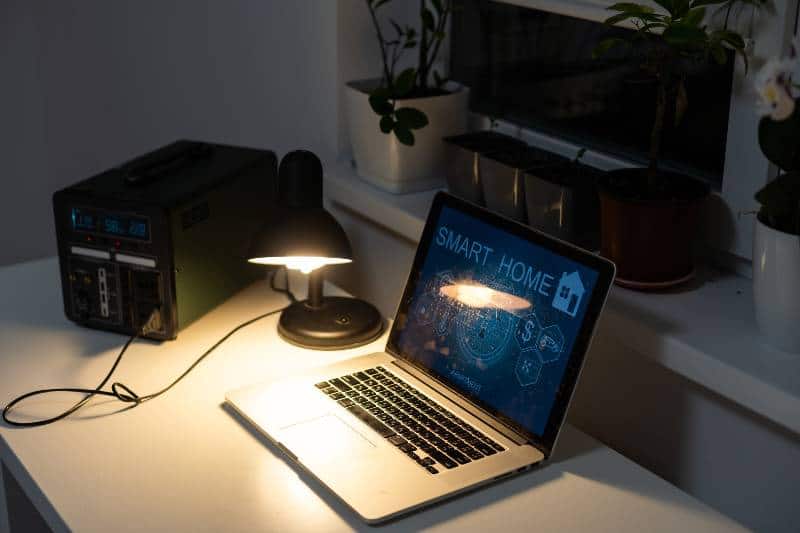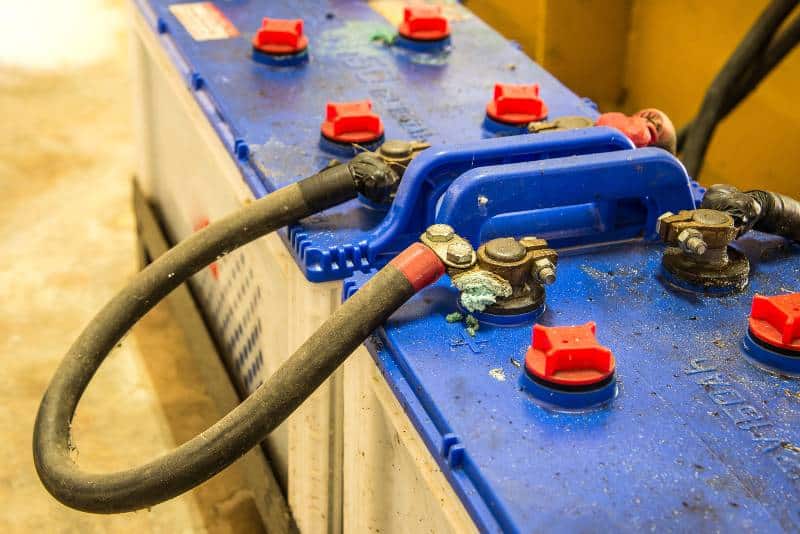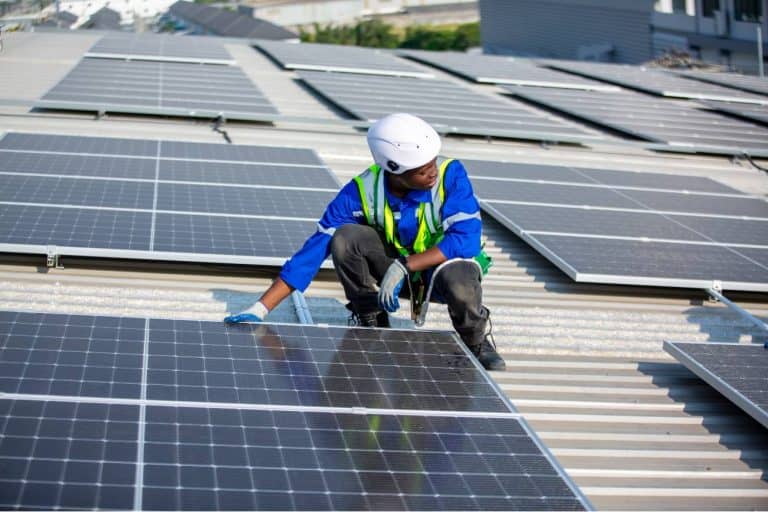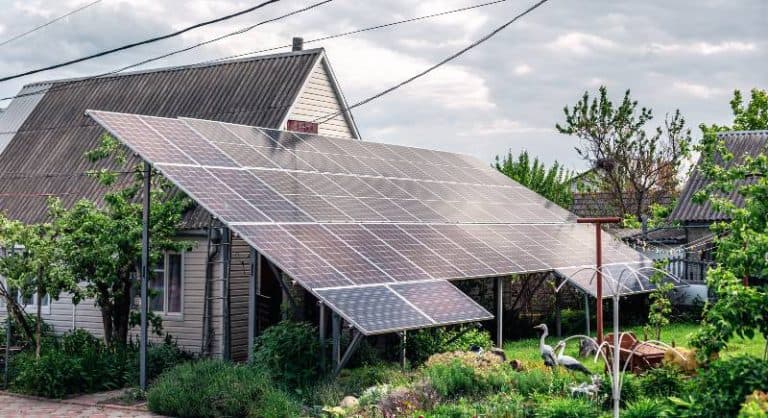Your Ideal Solar Battery Backup: A Comprehensive Selection Guide
Are you considering a solar battery backup system for your home? A solar-powered battery option could be just the solution to your energy needs – but how do you decide which is the best choice for you? With so many options available, it can be difficult to determine what type of system will fit your lifestyle and budget. This blog post will provide all of the necessary information needed to make an informed decision on which solar backup battery system is right for you. We’ll discuss key features to consider when selecting a battery size, brand technology, installation considerations, and more!
To select the right solar backup battery system, consider your power needs, checking the battery’s capacity and power ratings. Understand its lifespan and warranty details. Prioritize compatibility with your existing solar array. Decide between lithium-ion and lead-acid based on budget and efficiency. Choose systems with advanced features like remote management. Always consult with a professional for accurate sizing and installation.
Key Takeaways
- Understanding the different types of solar backup battery systems or solar panel system and their individual advantages and disadvantages is critical in making an informed choice.
- Several key factors such as capacity, depth of discharge, round-trip efficiency, battery life, and cost should be taken into account when selecting a solar backup battery system.
- The right choice of a solar backup battery system is not just about immediate needs, but also about considering future consumption patterns, scalability, and return on investment.

Understanding Solar Backup Battery Systems
A solar backup battery system, also known as a solar-plus-storage system, is an advanced renewable energy solution that combines solar panels with a battery storage system. This unique combination enables homeowners, businesses, and even communities to not only generate their own clean, sustainable electricity when the sun is shining but also to store excess energy for later use when the sun is not available, such as during the night or cloudy days. It provides an extra layer of security by acting as a backup power source during grid outages, ensuring a continuous supply of power when it’s needed the most.
To understand how this system works, it’s important to first understand its components. A typical solar backup battery system consists of three key parts: solar panels, a charge controller, and a battery storage unit.
Solar panels, as you probably know, are devices that convert sunlight directly into electricity. This electricity is generated in the form of direct current (DC), which is the type of electricity that batteries use for storage. However, most household appliances and systems use alternating current (AC), so the electricity generated by solar panels needs to be converted.
This is where the charge controller comes in. The charge controller is an electronic device that regulates the voltage and current coming from the solar panels. It ensures that the batteries are charged correctly, preventing overcharging and extending their life. In addition, many solar-plus-storage systems also include an inverter, which converts the DC power from the solar panels or the battery into the AC power used by most home appliances.
The third main component is the battery storage unit. The energy produced by the solar panels during the day, which is not used immediately, can be stored in these batteries. This energy storage capability is what sets a solar-plus-storage system apart from a typical solar-only system. The stored energy can be used during periods of low solar output, like at night or during cloudy days, or during power outages.
Let’s take a hypothetical example to illustrate how this system works. Imagine it’s a sunny day and your solar panels are producing more electricity than you need for your current energy consumption. Instead of that extra energy going back to the grid, it is directed to your battery storage system. The charge controller ensures that the power from your panels charges the batteries safely and effectively.
As the sun sets, your solar panels stop producing energy. But instead of having to purchase power from the grid, you start to draw from the energy you’ve stored in your battery system. This allows you to extend the benefits of your solar panels into the night. Moreover, if there is a power outage, your solar backup battery system can step in to provide power, thus ensuring that your key appliances keep running until grid power is restored.
A solar backup battery system is a brilliant, sustainable solution that leverages the sun’s energy to its maximum potential. Not only does it allow us to reduce reliance on the grid and decrease electricity bills, but it also provides peace of mind knowing that even in the event of a power outage, you’ll still have a reliable source of energy.
Types of Solar Backup Battery Systems
let’s delve into the various types of batteries that are used in solar backup systems. The battery technology chosen for a solar energy storage system can significantly impact the system’s performance, lifespan, and cost. Here are the most common types of batteries used for solar backup systems:
Lead-Acid Batteries
Lead-acid batteries are one of the oldest types of rechargeable batteries and have been used for many years in various applications, including solar energy storage. There are two types of lead-acid batteries: flooded (or wet cell) and sealed (which includes an Absorbed Glass Mat, or AGM, and Gel types).
Advantages: Lead-acid batteries have a lower upfront cost and are widely available. They’re also recyclable, which makes them an environmentally friendlier choice.
Disadvantages: They have a shorter lifespan compared to other types of batteries and require regular maintenance, especially flooded lead-acid batteries. They’re also less efficient in terms of energy storage and have a lower Depth of Discharge (DoD) compared to other types of batteries.
Lithium-Ion Batteries
Lithium-ion batteries are currently the most common type of battery used in solar energy storage, thanks to their high efficiency and long lifespan. This is the same technology used in electric vehicles and many portable electronic devices.
Advantages: Lithium-ion batteries have a higher DoD and longer lifespan than lead-acid batteries. They also require little to no maintenance and have a high energy density, which means they can store more energy in a smaller space.
Disadvantages: The main disadvantage of lithium-ion batteries is their higher upfront cost, although this can often be offset by their longer lifespan and superior performance.
Saltwater Batteries
Saltwater batteries, or aqueous hybrid ion batteries, are a newer type of battery technology that uses saltwater electrolytes to store energy.
Advantages: Saltwater batteries are safe, clean, and have a high DoD. They’re also completely recyclable and don’t contain any heavy metals, making them an environmentally friendly choice.
Disadvantages: Saltwater batteries are less energy-dense than lithium-ion batteries, meaning they require more physical space for the same amount of storage. They also have a shorter lifespan compared to lithium-ion batteries.
Flow Batteries
Flow batteries are a type of rechargeable battery where energy is stored in liquid electrolyte solutions that are contained in tanks. The most common type of flow battery is the vanadium redox flow battery.
Advantages: Flow batteries have a high DoD and a long lifespan. They can also be scaled up easily, making them suitable for large-scale energy storage.
Disadvantages: Flow batteries are more complex and larger than other types of batteries, making them less suitable for residential use. They also have a lower energy density compared to lithium-ion batteries.
Choosing the right type of battery for a solar backup system depends on a variety of factors, including the system’s size, the intended application, budget, and personal preferences regarding factors such as maintenance and environmental impact. Each battery type has its own advantages and disadvantages, making different technologies more suited to different applications.
Factors to Consider When Choosing a Solar Backup Battery System
Choosing the right solar backup battery system involves evaluating multiple factors to ensure the system meets your energy needs and fits within your budget. Here are some key factors to consider:
Capacity and Power
The capacity of a solar battery is a measure of how much electricity it can store, typically measured in kilowatt-hours (kWh). If you need the battery to power your whole house, you’ll need a larger capacity than if you’re only powering essential appliances.
Power, measured in kilowatts (kW), represents the amount of electricity a battery can deliver at one time. A battery with a high capacity and a low power rating could deliver a low amount of electricity (enough to run a few essential appliances) for a long time, while a battery with low capacity and a high power rating could run your whole house, but only for a few hours.
Depth of Discharge (DoD)
The DoD of a battery refers to the amount of the battery’s capacity that has been used. Most batteries need to retain some charge, as completely draining them can reduce their lifespan. For instance, if a battery has a DoD of 90%, this means that 90% of the battery’s capacity can be used. The higher the DoD, the more usable capacity the battery has.
Round-Trip Efficiency
Round-trip efficiency refers to the amount of energy that can be used as a percentage of the amount of energy it took to store it. For example, if you feed 5 kWh of electricity into the battery and get 4 kWh of useful energy back, the battery has an 80% round-trip efficiency. The higher the round-trip efficiency, the more economic value you get out of your battery.
Battery Life and Warranty
Batteries degrade over time, meaning they will hold less charge as they age. Manufacturers typically guarantee that their batteries will maintain a certain capacity for a certain number of years or cycles (one cycle refers to a battery charging up and then discharging). It’s important to consider this when comparing your options.
Costs and Savings
The cost of the battery system is not just the upfront cost but also includes the cost of installation, the inverter (if not included), and any additional balance of system components. These costs should be weighed against the savings the system will provide over its lifespan.
Some solar batteries can be eligible for financial incentives, such as the federal Investment Tax Credit (ITC) in the United States, which can significantly reduce the net cost of the battery. In addition, the savings achieved through reducing electricity bills, and potentially gaining energy independence, can also play a significant role in offsetting the initial costs.
By carefully considering these factors, you can choose a solar backup battery system that is most suited to your needs and circumstances, thereby ensuring maximum return on your investment.
This article I wrote in the past might also be helpful to you, it’s called Solar Power On-the-Go: Portable Solar Panels for Work and Play. It covers the advantages of using portable solar panels for work and leisure activities, as well as the features and benefits to look for when choosing a model. I also included some tips on how to make the most out of your portable solar panel setup. Hopefully, this article will help you make an informed decision about which one is right for you!
Examining Popular Solar Backup Battery Systems
Tesla Powerwall 2
The Tesla Powerwall 2 is one of the most recognized residential solar batteries. With a sleek design, it offers a capacity of 13.5 kWh and provides a 100% depth of discharge. It has excellent round-trip efficiency of approximately 90% and includes a built-in inverter. Powerwall 2 can be mounted on a wall or on the ground and can be charged from solar, or from the grid when electricity prices are low. It comes with a 10-year warranty, guaranteeing a certain amount of cycles.
LG Chem RESU
The LG Chem RESU battery series comes in a variety of capacities, from 3.3 kWh to 13.1 kWh, making it suitable for a range of residential applications. The RESU series boasts a depth of discharge of up to 95%, and round-trip efficiency of around 95%, making it a highly efficient battery option. It also has a lifespan of 10 years and can be mounted either indoors or outdoors.
Sonnen eco
The Sonnen eco series of batteries is another high-quality option for solar energy storage. These batteries range from 5 kWh to 20 kWh in capacity, making them suitable for both small and large homes. Sonnen eco batteries have a depth of discharge of 100% and boast a round-trip efficiency of around 90%. One key selling point of Sonnen batteries is their exceptional 10,000-cycle or 15-year warranty.
Enphase Encharge
The Enphase Encharge battery is designed to be modular and easy to install, with available capacities of 3.4 kWh and 10.1 kWh. The Encharge batteries have a 96% round-trip efficiency and a depth of discharge of 100%. These batteries also come with a 10-year warranty and have the added benefit of being able to function in off-grid situations when paired with the Enphase Ensemble energy management technology.
Blue Planet Energy Blue Ion HI
This premium battery storage system uses safe, recyclable, and energy-dense lithium ferrous phosphate (LiFePO4) chemistry. Blue Ion batteries come in configurations from 8 kWh to 16 kWh, with a depth of discharge of 100% and a round-trip efficiency of 98%. The standout feature is its impressive 15-year warranty, or up to 8,000 cycles, whichever comes first.
Remember, when choosing a solar backup battery system, factors like your home’s energy needs, your budget, and the specifics of your local electricity rates and solar policies should guide your decision. Always work with a knowledgeable, reputable solar installer to ensure you’re getting the best system for your needs.
Making the Right Choice
Choosing the right solar backup battery system can seem like a complex process, but by following these steps, you can make an informed decision that suits your needs:
Determine Your Energy Needs
The first step is understanding your energy needs. Look at your electricity bills to see how much energy your household uses on average, particularly during peak periods. In addition, consider which appliances or systems you would want to keep running during a power outage.
Evaluate Your Solar Energy System
If you already have a solar system installed, it’s important to ensure that it’s compatible with the battery system you’re considering. The system size, inverter type, and your solar production patterns are all key considerations. If you don’t already have solar panels, you’ll need to factor in their installation as part of your overall plan.
Consider Your Budget
Establish a budget for your battery storage system. Keep in mind that while the upfront cost might seem high, the potential savings over time can make the investment worthwhile. Also, be sure to look into potential incentives or rebates in your area that can help offset the cost.
Research Battery Types and Brands
As we discussed earlier, different types of batteries (lead-acid, lithium-ion, saltwater, flow) have varying characteristics in terms of lifespan, efficiency, maintenance, and cost. Research the pros and cons of each to decide which type suits your needs best. Once you have a sense of the type of battery you want, you can start to compare specific brands and models.
Compare Key Battery Specifications
When comparing specific batteries, consider the following specifications: capacity & power, depth of discharge (DoD), round-trip efficiency, lifespan, and warranty. Remember, a battery’s capacity tells you how much energy it can store, while power tells you how much energy it can deliver at a time. The DoD informs you how much of the battery’s capacity can be used, and the round-trip efficiency tells you how much energy is retained when electricity is stored and then retrieved from the battery.
Consult a Professional
Once you’ve done some research and have an idea of what you’re looking for, it’s a good idea to consult with a professional solar installer. They can help you assess your situation, recommend a system that fits your needs, and provide you with a quote. They can also answer any questions you have about installation, maintenance, and potential savings.
Make the Purchase and Schedule Installation
Once you’ve settled on a system, you can move forward with purchasing your solar backup battery and scheduling the installation. Ensure your installer is licensed and certified to carry out the job.
Remember, installing a solar backup battery system is a long-term investment, so it’s worth taking the time to do the research and make sure you’re choosing the right system for your needs. Not only will a well-chosen solar backup battery provide energy security, but it can also lead to significant energy cost savings over time.

How To Choose The Right Solar Backup Battery System FAQs
What factors should I consider when choosing a solar backup battery system?
When choosing a solar backup battery system, you should consider your home’s energy needs, your budget, the specifics of your local electricity rates and solar policies, as well as the type of battery (lead-acid, lithium-ion, saltwater, or flow), capacity & power output, depth of discharge (DoD), round-trip efficiency, lifespan, and warranty.
What is a depth of discharge (DoD)?
The depth of discharge (DoD) indicates how much of the battery’s capacity can be used. It’s expressed as a percentage and typically ranges from 20%-100%. A higher DoD means more energy can be drawn out before needing to recharge the battery.
How do I calculate the required capacity and power of a battery system?
To calculate the required capacity and power of a battery system, you’ll need to consider how much energy your household uses on average, particularly during peak periods. Adding up all the energy consumed in watt-hours will give you an idea of the system’s capacity (kWh) needs.
What is Depth of Discharge and why is it important?
Depth of Discharge (DoD) is the measure of how much capacity a battery can deliver from a full charge. It’s expressed as a percentage and typically ranges from 20%-100%. The importance of DoD lies in its effect on the lifespan of the battery; typically, deeper discharges will reduce the number of cycles or amount of time you can use your battery before it requires replacement. For this reason, batteries with a higher DoD are typically preferred for residential applications.
How does round-trip efficiency affect my solar battery performance?
Round-trip efficiency is the measure of how much energy is lost during storage and retrieval from a battery. Generally, higher efficiencies mean less energy is wasted in the form of heat or other losses. This makes it easier to maximize the value of your system since more of the electricity you store can actually be used when you need it. Are there
How long should a good solar backup battery last?
A good solar backup battery should last about 10 years or more with proper maintenance. However, the exact lifespan will vary depending on factors like the battery type, capacity & power output, depth of discharge (DoD), round-trip efficiency, and other conditions. Be sure to check the warranty before purchasing a system to ensure it meets your needs.
Conclusion
Now that we have explored the basics of how to choose the right solar backup battery system, it is easy to understand why careful research and preparation are critical in getting the most out of your solar energy setup. With a range of models, prices, and features on offer, the decision-making process requires patience and time for comparison.
Making sure that each part of your solar installation is high-quality will ensure long-term enjoyment and reliability in addition to making the most cost-efficient choice. Investing in a comprehensive solar battery system can be beneficial if you plan on generating enough electricity to change your entire lifestyle around renewable energy sources.
Let us leave off with a reminder – always consult a professional before making any decisions about installing electrical components in your home or business place! Make sure to sign up for our newsletter to receive the latest Electrik Living updates, advice, and exclusive offers!






